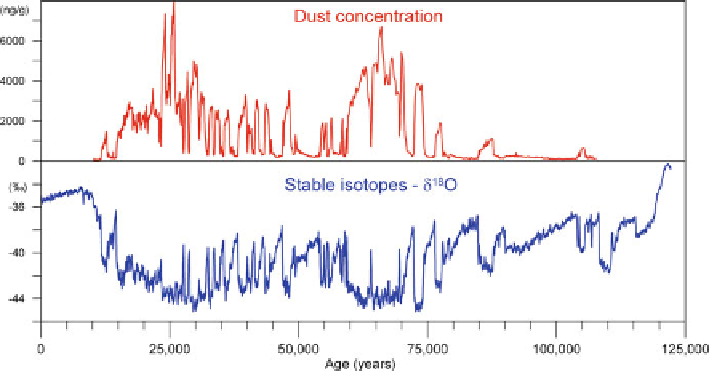Geoscience Reference
In-Depth Information
Fig. 18.4
The Greenland NGRIP ice core dust concentration profile (Ruth et al.
2003
) together
with the •
18
O temperature proxy from the same core (NGRIP members
2004
). The more negative
the •
18
O proxy, the colder it is
this respect, the dust concentrations follow the typical pattern of most Greenland
chemical impurities (Mayewski et al.
1997
). Close to the Last Glacial Maximum,
at around 25 ka BP, the most extreme dust events occur with dust concentrations of
80-100 times that of interglacial and present day conditions.
The great dust concentration variability of the Greenland ice is thought to have
several causes (Fuhrer et al.
1999
; Fischer et al.
2007b
): First of all, the continental
dust sources may have varied in extent and productivity over time (see discussion
Sect.
18.4.2
). Secondly, the transport efficiency from the sources to Greenland is
thought to have varied importantly with climate. During the coldest periods of
the last glacial, the high latitude air masses have been relatively dry allowing for
reduced wash-out of dust and more efficient long range transport. Furthermore, the
latitudinal temperature gradient is thought to have been strong which has caused
stronger winds for dust uplift and long-range transport. Finally, changes in amounts
of Greenland precipitation influence the dust concentration of the ice. During the
coldest glacial periods the snow accumulation was less than half of that of milder
periods, so snow accumulation changes alone can thus account for a factor of two
or more of the observed dust concentration variability depending on the relative
amounts of wet and dry deposition.
At present day, the Greenland dust deposition shows a clear seasonal variability
with most of the dust being deposited during springtime (Drab et al.
2002
;Banta
et al.
2008
)(Fig.
18.5
). By application of seasonally resolved measurements of
various major chemical impurities that all show a strong seasonal pattern this dust-
spring pattern can be traced throughout the Holocene period (Rasmussen et al.
2006
).

Search WWH ::

Custom Search